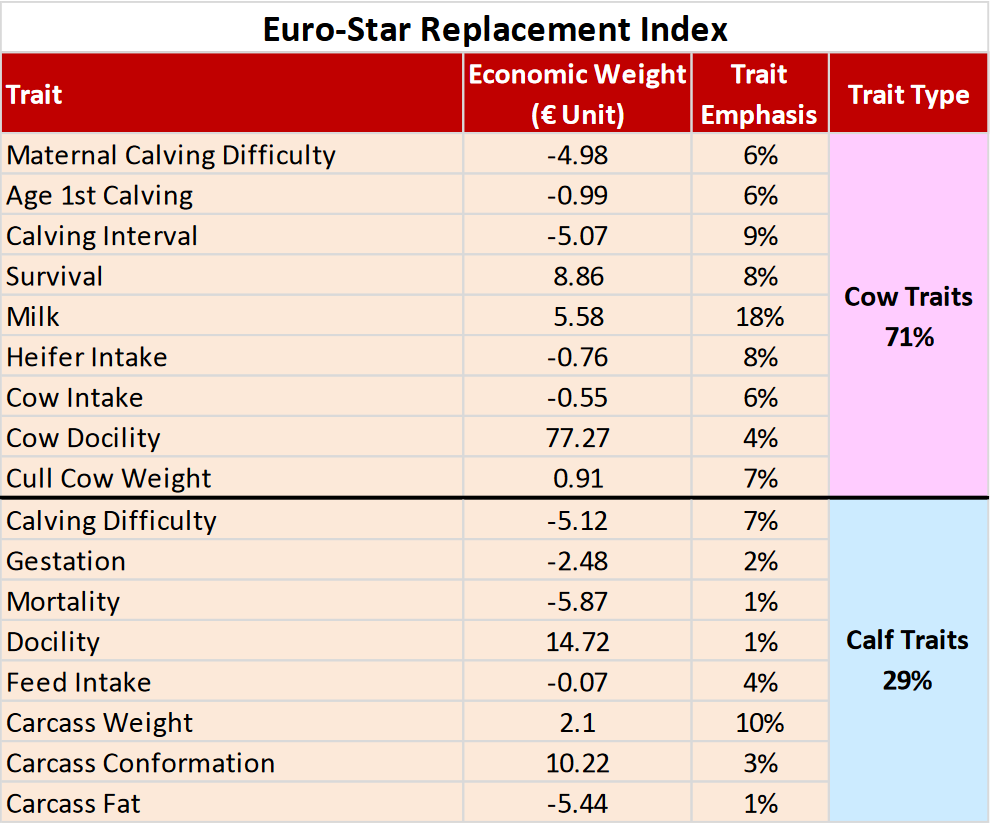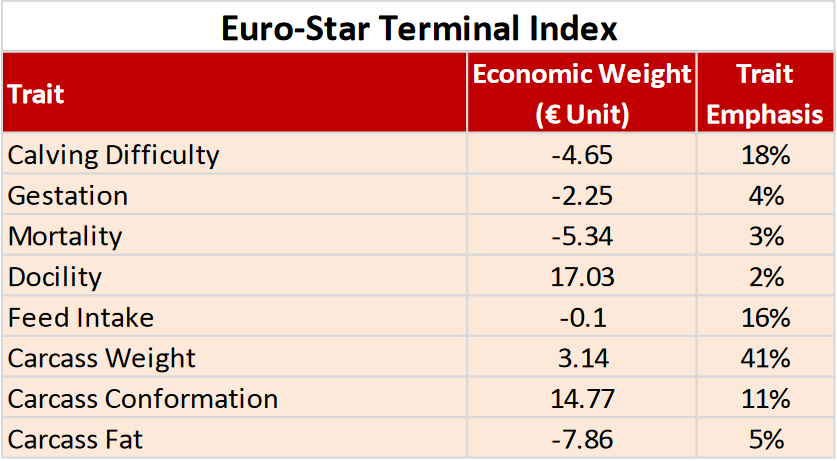The Euro-Star Index is a breeding index designed to aid beef farmers in the selection of more profitable breeding animals. Euro-Star Indexes quantify the genetic component of an animal’s performance across all traits of importance for Irish suckler farmers.
Two Overall Indexes in Beef
The Euro-Star Index has two overall indexes – the Replacement Index and the Terminal Index. This is to facilitate the use of Euro-Star Indexes across different farming systems. Some farmers may breed their own replacements, in which case the Replacement Index is most relevant. Other farmers may sell all of their suckler progeny as weanlings or take them through to slaughter, in which case the Terminal Index is most relevant.
Replacement Index
The Replacement Index is a monetary (€) figure which is expressed as profit per calving of each daughter i.e. a bull with a Replacement Index of €150 is expected to produce daughters that will leave, on average, €150 extra per calving over the base animal. There are 17 traits included in the Replacement Index. Each trait has its own Predicted Transmitting Ability (PTA). An animal’s PTA is the amount of a trait that it can pass on to its progeny. The PTA for each trait is then multiplied by the Economic Weight (monetary value for each unit of the trait). This generates a Euro value contribution for the trait. All of these values are then combined to add up to the overall Replacement Index. Table 1 details all of the traits included in the Replacement Index as well as their respective Economic Weights.

Terminal Index
The Terminal Index is also a monetary (€) figure which is expressed as profit per direct progeny slaughtered i.e. a bull with a Terminal Index of €150 is expected to produce progeny that will leave, on average, €150 extra at slaughter over the base animal. There are 8 traits included in the Terminal Index. Again, just as in the Replacement Index, each trait has a PTA and an Economic Weight which are multiplied to give the Euro value contribution of that trait. All of the relevant trait contributions are then combined to add up to the overall Terminal Index. Table 2 details all of the traits included in the Terminal Index as well as their respective Economic Weights.

Star Ratings
The star rating system (1-5 stars) was incorporated into the Euro-Star Index to make it easier for farmers to interpret – 5 stars being good, 1 star being poor. This concept has been largely successful in its adoption by the industry, but there are some important points to remember:
- There are within and across breed stars. It is very important to know the difference. Within breed stars rank an animal only against other animals within its own breed. Across breed stars rank an animal against all animals across all breeds. An animal that ranks highly on a particular index or trait within its own breed might only be average or poor when ranked across all breeds.
- There are multiple indexes and traits that have a star rating. A bull could be quoted as a “5 star bull”. But 5 stars for what? 5 stars on a certain trait or on one of the overall indexes? 5 stars within or across breed? Farmers need to ask these questions.
- Look at the index or trait PTA first, then the star rating. It is easy to overly rely on the star ratings. While they are important and do tell you where an animal ranks, it is important to focus on the actual index or trait PTA value first. Currently, an animal with a Replacement Index of €100, for example, will be 5 stars across breed. A bull with a Replacement Index of €200 will also be 5 stars across breed. If compared on stars alone, one would think the bulls are equal (5 stars), but there is a vast difference in their actual Replacement Index figures.
Trait Emphasis
In both tables 1 and 2 you will see there is a column giving the trait emphasis percentage. The trait emphasis basically means the average contribution of each trait to the index of the average, proven AI bull. For example, carcass weight makes up 41% of the Terminal Index. This means that, on average, proven AI bulls are getting 41% of their Terminal Indexes from carcass weight. This is an average and some bulls will be getting more than 41% and some bulls will be getting less. Every bull will be different. Again, this is why it is important to look at the PTA values of each bull when looking at an index.
Reliability
Understanding reliability is an important element to interpreting the €uro-Star Index of any animal. Put simply, the reliability figure gives an indication as to how confident ICBF can be that an index or trait figure will not change in the future as more data is recorded. Where low reliability bulls are being used, it is important to use a team of bulls to protect against future fluctuations. Where bulls are being used on maiden heifers, it is important that they have a low calving difficulty figure (<5%) with a high reliability (>90%). Bulls with low reliabilities on calving difficulty should never be used on maiden heifers.
